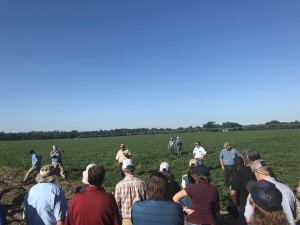As a research agronomist for the University of Georgia, Dr. Scott Tubbs conducts research in a lot of different areas and during the 2018 Georgia Peanut Tour Dr. Tubbs had an opportunity to present his research to the tour attendees. Some of that relates to cropping systems with rotations of peanuts and other crops. Farmers may have more success growing peanuts if they don’t continuously plant peanuts in the same field, and that is the message Dr. Tubbs is wanting to convey. Other crops that rotate very well with peanuts include corn and cotton and there’s about a million plus acres of cotton any given year, anywhere between 250,000 300,000 acres of corn any given year and this is about twice as much acreage as what we have in peanuts. “With a rotation on peanuts we usually recommend three years rotation, two years out of peanuts before we go back into peanuts the third year. The acreage of these rotation crops allows this except when we increase acreage of peanuts and decrease acreage of these other crops. It does put our rotation under pressure for shorter rotations which can cause additional disease and pest problems with weeds and insects as well”, says Dr. Tubbs. Peanuts do rotate well with other crops since it is a legume. Peanuts have a lot of nitrogen they can supply to other crops that are usually fertilized with nitrogen so peanuts are a good scavenger of nutrients by pulling those nutrients from deep in the soil profile by bringing those back to the surface.
“Once the peanut is harvested the remaining residue of peanut is left on the ground and will disintegrate and provide nutrients to the subsequent crops that are planted behind peanuts,” he continues. “Some of the research I am conducting this year include replant decisions for peanut and populations including gap situations where we force a stand gap where there are no plants growing just to assess the yield drag from having no populations in the field. We also conduct research on inoculants, different formulations and their interactions with other in furrow products that are placed in ground at planting. This year we initiated some trials on physical damage to peanuts to simulate hail damage or deer damage to peanuts and we are assessing different levels of damage by different timings of the crop just to assess how yield and grade will be affected at the end of season with these different damage levels with different timing.”
For more information on crop rotation, visit the UGA Extension publications by clicking here.







